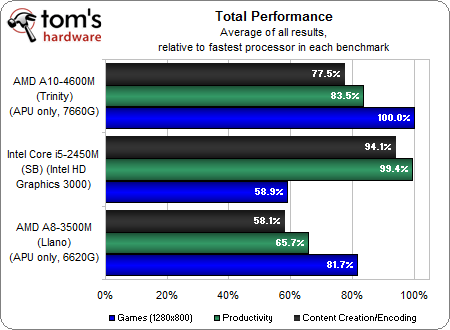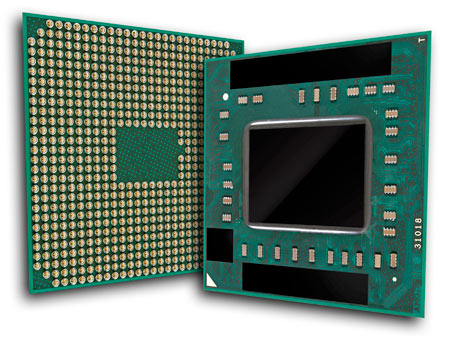AMD A10-4600M Review: Mobile Trinity Gets Tested
AMD steps up to the plate with an all-new processor. Armed with the updated Piledriver CPU core and VLIW4 graphics architecture, the Trinity APU represents an impressive improvement over the Llano generation. But can it stand up to Intel's best efforts?
Tripling Your Pleasure With Trinity?
Before we wrap this piece up, have a look at one last chart: a comparison of average performance.
AMD’s Trinity-based APU doesn’t unseat Sandy Bridge from its position of performance supremacy. Nor will it oust Ivy Bridge when third-gen Core i5-based notebooks start to appear. But it sure holds up a lot better than Llano.
Perhaps more significant, though, is that it boosts graphics performance significantly. Although Trinity devastates HD Graphics 3000, it’ll be able to use that extra speed to help stave off forthcoming Ivy Bridge-based parts with HD Graphics 4000, too. If you’re a casual gamer, it’s pretty easy to recommend the Trinity-based A10-4600M over Intel’s Core i5-2450M. Conversely, if you don’t plan on gaming at all on your mobile device, the Sandy Bridge-based Core i5 becomes the easier choice. That’s almost the same conclusion we reached when Llano was launched.
As with many things in life, though, the breakdown isn’t quite so simple. There are some other important factors to consider, such as the fact that Ivy Bridge-based Core i5 notebooks are expected to land within the next couple of months. Intel’s more mid-range 22 nm CPUs are expected to include HD Graphics 4000—an implementation we consider to be Intel’s first serious move against AMD’s graphics dominance. In addition, Ivy Bridge fits within a smaller power envelope and delivers slightly better application performance. As we showed in Core i7-3720QM: Ivy Bridge Makes Its Mark On Mobility, the architecture challenges Llano’s gaming alacrity, while pushing application performance even further. We haven’t tested Trinity against a similarly-priced Ivy Bridge-based Core i5 yet, but, at the end of the day, the difference between each company’s new hardware may parrot the delta we’ve already seen separating the old platforms. We’ll bring you those results as soon as we can get our hands on the right hardware.
What about our pledge to more intently consider features that can’t be benchmarked? Truly, we’re impressed with AMD’s efforts to court software developers and get GPU acceleration implemented as a feature in several different relevant segments and titles—much more so than when we were having this same discussion last year. The only problem is that none of the enhanced applications are universally appealing. For example, AMD Steady Video does a great job of stabilizing shaky video streams. But what if you simply don’t have enough shaky video to pay the feature much mind? Even still, we certainly encourage AMD to continue pushing the adoption of GPU-accelerated software that appeals to broad audiences. Getting GIMP, HandBrake, vReveal, WinZip, and other titles optimized is a great way to demonstrate the benefits of compute-oriented optimizations. Two things, though: first, we’d like to see the impact of GPU acceleration more definitively outpace the performance of a competing processor lacking the requisite support, and second, don’t lock other vendors out of what is supposed to be an open ecosystem.
Finally, what of our promise to consider mainstream end-user tasks when making recommendations about mainstream hardware? Frankly, even power users spend much of their time checking email, browsing the Web, writing in Word, and of course gaming. To be honest, it’s be hard to distinguish between two blindly-configured platforms—one Intel, one AMD—in most tasks. The exception is gaming, where AMD’s Trinity design really shines.
A couple of questions remain: how does Trinity stack up to a comparably-priced Ivy Bridge-based notebook, and when can we expect to start seeing Trinity-based notebooks for sale? We’ll bring you answers to both as soon as possible.
Get Tom's Hardware's best news and in-depth reviews, straight to your inbox.
Current page: Tripling Your Pleasure With Trinity?
Prev Page Power ConsumptionDon Woligroski was a former senior hardware editor for Tom's Hardware. He has covered a wide range of PC hardware topics, including CPUs, GPUs, system building, and emerging technologies.
-
Recently Charlie at semiaccurate (a massive amd fanboy) hinting an upcoming apple products, then I saw an article in thg that tells an upcoming mbp will using retina display... 15 inch retina will require huge gpu horsepower, my wild guess is mbp will use trinity as it's CPU.Reply
-
Based on this, gaming is much better than old i5, but everything else including application performance is still better on the old Sandy architecture. I'm not really sure why I would buy a Trinity other than for a casual gaming laptop. Unfortunately, budget says that my laptops have to be used for business first, play time later.Reply
-
beenthere Nice to see that Trinity and AMD have delivered the goods. I want a Trinity powered Ultrathin. Intel can stick their crap where the Sun don't shine.Reply
BTW, Charlie @ SemiAccurate is not an AMD fanbois IME. He just calls it like it is. Reality bites sometimes be it Nvidia, AMD or Intel's problems. Denial never changes reality. It is what it is. -
cleeve duckwithnukesWhere is the Intel HD 4000 vs. AMD Trinity comparison? Lazy reviewing at its finest.Reply
A10-4600M laptops will be int eh $600-$700 neighborhood, and we're still waiting for Ivy bridge Core i5 to arrive in this price range.
We go over this. We also talk about how we'll do a follow up as soon as an appropriate product is available.
You need to read for it to make sense.
-
FlippyFlap, Apple doesn't use AMD and an HD4000 can power a retina display. I'm sure Apple has worked with Intel engineers to get the drivers right for retina displays which is HD4000's problem. HD4000 is still lacking in terms of driver support (one can see that from the OpenCL benches around the net where only 1/2 get acclerated on HD4000). When the drivers work right, there isn't much difference between Ivy and Trinity.Reply
-
I agree with Cleeve and I personally hate comparing a reference system to a selling system anyway. Review 2 actual selling systems with similar parts and that gives you the benchmark.Reply
-
DRosencraft This looks like a very nice effort from AMD. I really, really need to replace my notebook. It's a six year old Toshiba Satelite with an AMD 1.9 GHz Turion 64 X2 with intergrated X2100 graphics.... yeah. Ancient now, I know. I've been trying to figure out a sweet spot in power since my needs are kind of complex. Typically I don't need it to do much more than handle MSOffice and web surfing. But I also tend to use it for video gaming when am interesting game comes around and some work in PaintShop when I'm out of the house, or don't feel like sitting at my desktop. This may be a little closer to what I'd like. It would be nice to get a notebook that combines this with a really good discrete card (sort of like how some MacBook Pros have their dual graphics setup). Nevertheless, Trinity looks to be just about enough power and performance, but the question is price. If tradition holds, it should be a good price competitor with Intel, which is the most important part, otherwise I'd just buy a core I7 already.Reply
In a related question, does Trinity's details and specs lead to any conclusions about what Piledriver desktop processors will be like? -
neoverdugo So this means that AMD can kick Intel's ass in the gpu department for the moment while AMD suffers greatly in the CPU portion of the apu battle. Didn't I said before that Intel is trying to make an (proprietary) Intel only PC with no third party strings attached? We all know that there is no competition in the CPU battle when it comes to Intel. Still, i would like to see that the morons of intel to drop the price of their hardware for once and for all and drop ridiculously low end hardware out of production.Reply -
dgingeri No WoW benchmarks this time? I was wondering if this might make a good laptop for WoW, but you guys failed me. :(Reply

